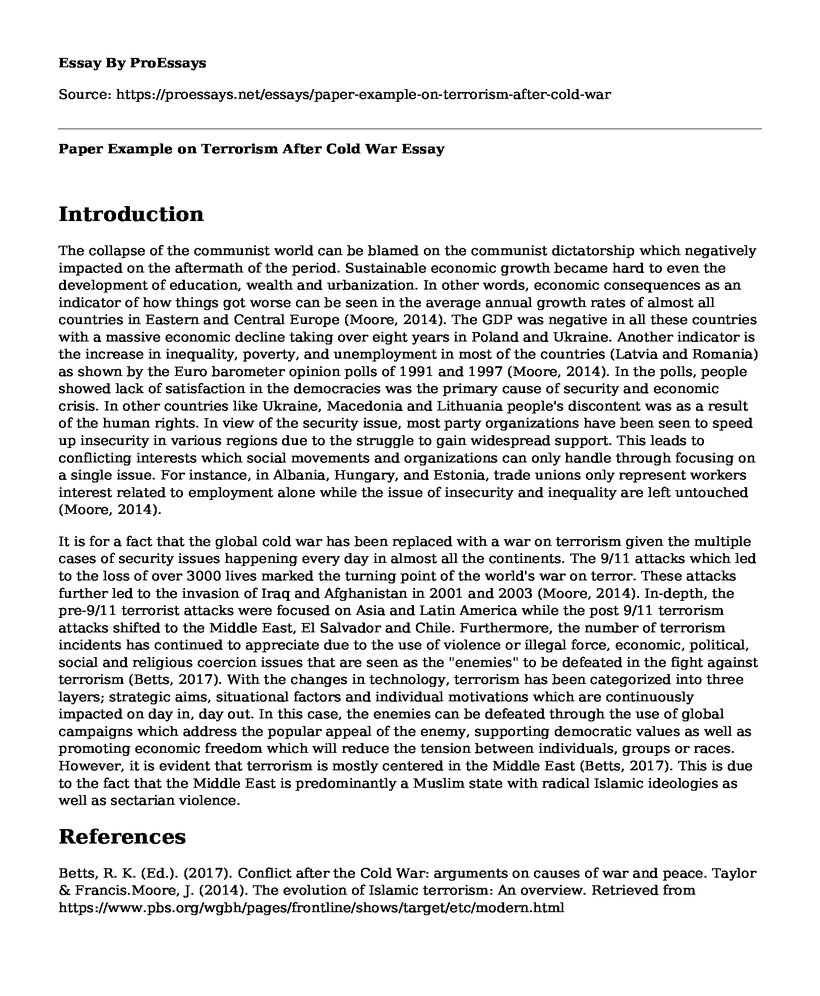Introduction
The collapse of the communist world can be blamed on the communist dictatorship which negatively impacted on the aftermath of the period. Sustainable economic growth became hard to even the development of education, wealth and urbanization. In other words, economic consequences as an indicator of how things got worse can be seen in the average annual growth rates of almost all countries in Eastern and Central Europe (Moore, 2014). The GDP was negative in all these countries with a massive economic decline taking over eight years in Poland and Ukraine. Another indicator is the increase in inequality, poverty, and unemployment in most of the countries (Latvia and Romania) as shown by the Euro barometer opinion polls of 1991 and 1997 (Moore, 2014). In the polls, people showed lack of satisfaction in the democracies was the primary cause of security and economic crisis. In other countries like Ukraine, Macedonia and Lithuania people's discontent was as a result of the human rights. In view of the security issue, most party organizations have been seen to speed up insecurity in various regions due to the struggle to gain widespread support. This leads to conflicting interests which social movements and organizations can only handle through focusing on a single issue. For instance, in Albania, Hungary, and Estonia, trade unions only represent workers interest related to employment alone while the issue of insecurity and inequality are left untouched (Moore, 2014).
It is for a fact that the global cold war has been replaced with a war on terrorism given the multiple cases of security issues happening every day in almost all the continents. The 9/11 attacks which led to the loss of over 3000 lives marked the turning point of the world's war on terror. These attacks further led to the invasion of Iraq and Afghanistan in 2001 and 2003 (Moore, 2014). In-depth, the pre-9/11 terrorist attacks were focused on Asia and Latin America while the post 9/11 terrorism attacks shifted to the Middle East, El Salvador and Chile. Furthermore, the number of terrorism incidents has continued to appreciate due to the use of violence or illegal force, economic, political, social and religious coercion issues that are seen as the "enemies" to be defeated in the fight against terrorism (Betts, 2017). With the changes in technology, terrorism has been categorized into three layers; strategic aims, situational factors and individual motivations which are continuously impacted on day in, day out. In this case, the enemies can be defeated through the use of global campaigns which address the popular appeal of the enemy, supporting democratic values as well as promoting economic freedom which will reduce the tension between individuals, groups or races. However, it is evident that terrorism is mostly centered in the Middle East (Betts, 2017). This is due to the fact that the Middle East is predominantly a Muslim state with radical Islamic ideologies as well as sectarian violence.
References
Betts, R. K. (Ed.). (2017). Conflict after the Cold War: arguments on causes of war and peace. Taylor & Francis.Moore, J. (2014). The evolution of Islamic terrorism: An overview. Retrieved from https://www.pbs.org/wgbh/pages/frontline/shows/target/etc/modern.html
Cite this page
Paper Example on Terrorism After Cold War . (2022, Jul 27). Retrieved from https://proessays.net/essays/paper-example-on-terrorism-after-cold-war
If you are the original author of this essay and no longer wish to have it published on the ProEssays website, please click below to request its removal:
- Essay Sample: Gangs in Trenton, New Jersey
- Whole Women's Health V. Hellerstedt Paper Example
- Testing on Human Vs Testing on Animals Essay Example
- Malcolm X: Fight for Freedom & Equality - Essay Sample
- Youth Substance Abuse: Rising Problem in Schools - Essay Sample
- Essay Example on Decline of Child Labor in 19th Century Europe & North America
- Paper Example on US Drone Strikes: Targeting Terrorists Beyond War Zones







